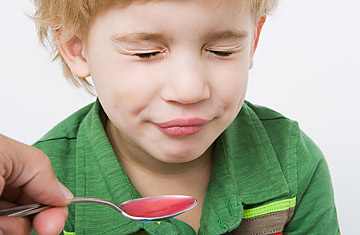
When you need relief from that cold or cough, do you use a spoon to measure the quantity? If you do, you're like millions of people — and like them, you're probably taking the wrong dose.
In a study published in this month's Annals of Internal Medicine, Cornell University researchers asked 195 university students to pour out 1 tsp. (5 ml) of cold medicine into kitchen spoons of various sizes. Consistently, the subjects botched the job, pouring out an average of 8% too little or 12% too much, depending on spoon size. Using a medium-size tablespoon they erred on the side of caution and tended to underdose. Using a large tablespoon, they overcompensated and overdosed. That is where the real danger lies.
"Twelve percent may not sound like a lot," says Brian Wansink, professor of marketing at Cornell and director of its food and brand lab. "But this goes on every four to eight hours for up to four days. So it really adds up to the point of ineffectiveness or even danger." Increasing numbers of over-the-counter medications come with dosing cups, but many people lose them, don't like them or don't know how to use them and simply feel more comfortable with a spoon.
It may not be surprising that consumers can't accurately judge a teaspoon of medicine without the aid of the teaspoon itself, but the reason for the error tells us something about how our perceptions work — or fail to work. It's well established that smaller plates can help people pile on less food and taller glasses may make even skilled bartenders pour more alcohol. Similarly, 5 ml on a teaspoon pretty much covers the entire surface area of the spoon and thus looks like a lot to us. But the same 5 ml on a large spoon somehow appears to be less, and as a result we add more.
When it comes to pain and cold medicine, this may be particularly worrisome. Tylenol, NyQuil and other drugs that contain acetaminophen are among the best-selling meds on the market, with more than $2.6 billion in sales in the U.S. in 2008. But acetaminophen can also put stress on the liver. From 1990 to 1998, there were an estimated 56,000 emergency-room visits, 26,000 hospitalizations and 458 deaths related to acetaminophen overdoses, according to the Food and Drug Administration (FDA). These figures include everything from attempted suicides to people who gulped down entire bottles trying to get well, and it is difficult to tease out just how many people got sick because of tiny overdoses. To address at least some of these cases, the FDA convened a panel of experts in June 2009 and charged them with the task of evaluating the safety of acetaminophen-containing drugs. That panel recommended various steps, including reducing the maximum daily dosage of acetaminophen and making Tylenol Extra Strength a prescription-only medicine.
The perils of acetaminophen can be particularly acute for two groups: drinkers — whose livers may already be working overtime — and kids. Unlike doses for adults, those for children tend to be very precise, right down to the milligram, which means even a single, small overdose is something to be avoided. Even more confounding is the counterintuitive way in which the formulation of a drug for infants can differ from that for an older child: the infant's version can actually be stronger since it is often administered in tiny amounts with a medicine dropper. "We've done studies here that show that 50% of the time, parents give the wrong dose" to a child, says Dr. Benard Dreyer, a professor of pediatrics at New York University. "We recommend parents don't use spoons at all."
Dosing cups and droppers aren't perfect answers for either adults or kids because level markers are not always clearly visible. Dreyer believes pictograms on packages can improve accuracy, showing just what 5 ml or any other proper quantity looks like in a cup or a syringe. One thing almost no one recommends is adding warnings to packages explicitly advising consumers against using spoons. "If at some time the dosing cap is missing, they may just instead drink off the bottle," says Duke University's Ruth Day. "That's the absolute worst."
